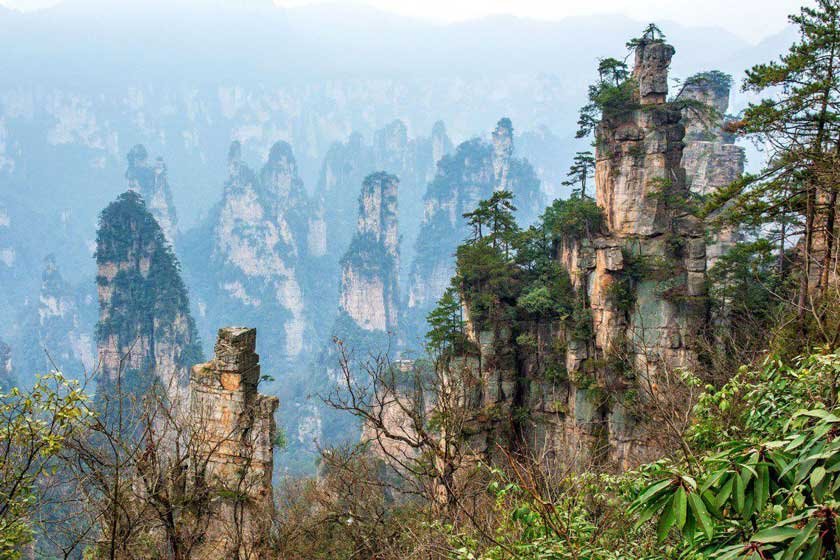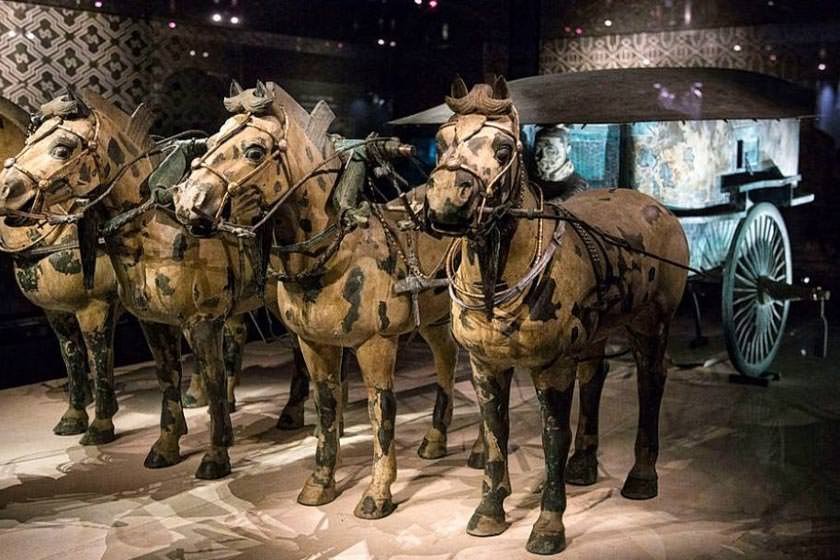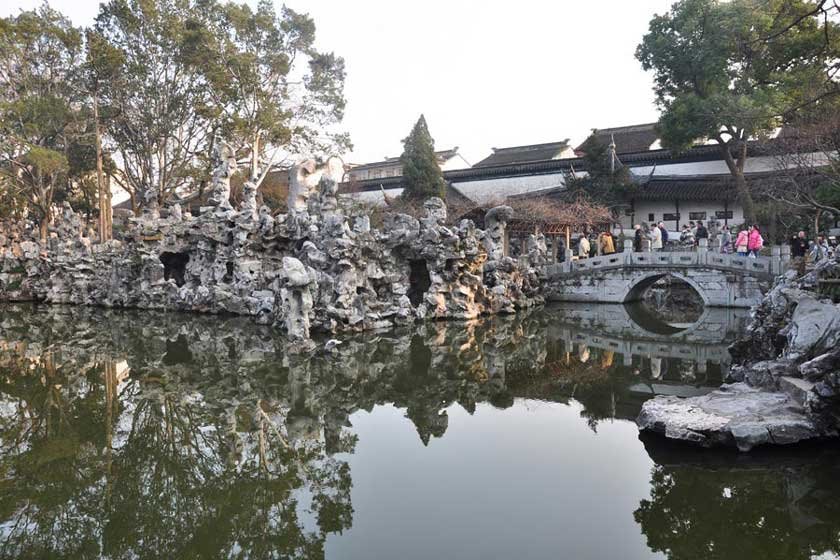Sights of China
Big Buddha Leshan
Leshan Great Buddha, also known as Lishan Great Buddha, is located in the southern part of Sichuan Province in China, near the city of Leshan, and was built during the Tang Dynasty (around 800 AD). This place is considered the first place of Buddhist worship and one of the most important sacred places of Buddhism. The height of this stone figure is 71 meters and it is considered the largest stone Buddha in the world. Its shoulders are 28 meters wide and its head is 14.7 meters long and 10 meters wide. 100 people can easily fit on the 8.5 meter legs of this statue. Leshan Big Buddha was registered as a UNESCO World Heritage Site in 1996. Although this statue has been exposed to the weather for many years and suffered damages, its greatness has not diminished.
The Forbidden City

The Forbidden City, also known as the Palace Museum of Beijing, consists of a series of palaces located in the center of Beijing, the capital of China. With an area of about 100 hectares, this complex consists of 9 thousand rooms. The construction of palaces began in the 15th century during the reign of the Ming Dynasty and was renovated and reconstructed until the reign of the Qing Dynasty. As the largest collection of ancient wooden buildings in the world, the Forbidden City has been registered in the UNESCO World Heritage List. Currently, the museum of the collection of works discovered from the Ming and Qing dynasties is located in this collection, and it is a good place to learn about the deep history of China.
Zhangyi Danxia National Geological Park

Zhangyi Danxia National Geological Park has an area of 322 square kilometers. Famous for its colorful rock formations, this area is one of the most beautiful geological landscapes in China and has no equal. Due to the presence of red sand and the pressure exerted on them by the earth, these lands have become in their present form. In 2010, Zhangye National Geological Park was registered in the UNESCO World Heritage List.
The ancient city of Pingyao

The ancient city of Pingyao was considered the financial capital of China in the 14th century. Today, due to the presence of historical monuments, this city is registered in the UNESCO World Heritage List. The narrow medieval streets and old shops of this city will take you on a journey back in time. Pingyao also has many historical sites from the Ming and Qing dynasties. In September, the lantern festival is held in this city, and the entire Pingyao takes on a romantic color and scent.
Mogai Cave

Mugai Cave, also known as the Thousand Buddha Cave, is located in the Gobi Desert and contains 492 temples. Valuable murals and more than three thousand statues are located in these caves, which date back to the 4th to 14th centuries. Mugai Cave is known as the largest and richest house of Buddhist art in the world and is registered in the UNESCO World Heritage List.
Potala Palace

The Potala Palace, or Potala Palace in other words, was the permanent residence of the Dalai Lama until Tenzin Gyatso, the 14th Dalai Lama (the current Dalai Lama), fled to India. This beautiful palace takes its name from Mount Potala, which is considered a sacred mountain in Buddhism. According to legends, the Tibetan king, Sangtsen Gampo, built this palace in the 7th century AD to pay respect to his bride, who was a princess from the Tang Dynasty. This palace was severely damaged during various wars and later it was repaired and rebuilt. Years after the fall of the Gampo dynasty and during the war, this palace was also destroyed. The current palace was rebuilt during the years 1644 to 1911 by the Qing Dynasty. With 9 floors and hundreds of rooms, Potala Palace consists of two parts; Red Palace and White Palace. The name of this valuable work has been registered in the UNESCO World Heritage List.
Zhangjiajie National Forest Park

Zhangjiajie National Forest Park is one of the most beautiful national parks in China. This park, which is located in the beautiful area of Welingyang, 270 km from Changsha, the capital of Hunan Province, China, is surrounded by dense forests. It contains thousands of stone pillars, some of which are several hundred meters high. Exemplary and unique nature with wildlife, river and indescribable waterfalls are among the features of this region. Among the other attractions of the park, we can mention the Bilang elevator, which is the world's highest outdoor elevator with a height of 326 meters, and its three sides are made of glass. In addition, the longest and highest glass bridge in the world with a length of 430 meters and a height of 300 meters, i.e. Zhangjiajie glass bridge and the longest cable car in the world with a length of 7455 meters have also been built in this national park. Zhangjiajie National Park was registered in the UNESCO World Heritage List in 1992, and in 2004 it was announced as the largest global geopark.
Beijing Summer Palace

The Beijing Summer Palace in the northwest of the city of Beijing is a magnificent and historic complex of palaces, lakes and gardens. With an area of 2.9 square kilometers, this complex was built during the Qing Dynasty. The gardens of this collection are considered as one of the best examples of Chinese gardens in the world. The different features of the complex, such as natural hills, lakes, tombs, flowers and palaces, all together form a beautiful and harmonious complex. Due to its cultural and historical value, the Summer Palace has been registered in the UNESCO World Heritage List.
China's Terracotta Army
The Terracotta Army of China, which is also known as the Terracotta Army of China and Terracotta Army, includes more than seven thousand statues of soldiers of the Chinese Royal Guard along with 130 military carriages and 520 horses in a space equal to 16,300 square meters. The body and size of these soldiers are equal to the size and dimensions of a normal human and none of them are completely similar to the other. These figures were buried in the soil more than two thousand years ago and were discovered by local people in 1974 by chance. This site is registered in the UNESCO World Heritage List.
The garden of the humble governor

The Garden of the Humble Governor, also known as the Garden of the Humble Manager, is one of the most famous gardens in Suzhou, China, covering an area of 5.2 hectares. This garden is known as the largest garden in Suzhou and one of the largest in southern China. In addition to beautiful natural landscapes, ponds, islands and old trees, there are many buildings, pavilions and bridges in the garden. Due to its historical and cultural value, the humble governor's garden is also registered in the UNESCO World Heritage List.
Mutianio Great Wall

The Mutianyu Great Wall is a part of the Great Wall of China, which is located 70 kilometers northeast of the center of Beijing. With a length of five kilometers, Mutianyu is considered one of the healthiest parts of the Great Wall of China. In the past, this part was used as a barrier to defend the capital and the tomb of the emperors. As part of the Great Wall of China, Mutianyu is registered in the UNESCO World Heritage List. If you hate crowds or have children with you, this section of the Great Wall of China is the best option for you. After watching the surrounding scenery and walking on the wall, you can slide all the way down the mountain and capture an unforgettable memory.
Emperor Qin's tomb

Emperor Qin's tomb was built in China between 208 and 246 AD and is located under a pyramid-like hill with a height of 76 meters. The main tomb, which contains the coffin and other buried parts, is considered the core of this cultural complex. The emperor's tomb has not been excavated due to lack of funds and it seems that most of his treasures were buried with him. On the eastern side of the hill, in 1947, a local farmer discovered the Terracotta Army of China, an army of 8,000 soldiers, 130 chariots with 520 horses and 150 cavalry guarding the tomb of Emperor Qin I. One of the wonders of the army is the dissimilarity of the soldiers. About 2,000 years ago, these statues were buried with the emperor so that, according to an old belief, in the world after death, they would be guardians of his royal temple and protect him from enemies. Due to its cultural and historical value, this tomb has been registered in the UNESCO World Heritage List.
Western Lake

The fresh water West Lake is located in Hangzhou, China, and with an area of 6.4 square kilometers, it is divided into five parts. Many temples, pagodas, gardens and artificial islands are located in this lake. Due to its natural beauty and cultural monuments, West Lake has inspired many poets and painters throughout Chinese history and has had an important influence on Chinese garden designers. Also, this lake, which is surrounded by hills on three sides, is one of the most important sights of Hangzhou. Due to its historical, natural and cultural value, Western Lake is also registered in the UNESCO World Heritage List.
Norbulingka Palace

Norbolingka Palace and its surrounding parks were built in 1775 in Lhasa, located in Tibet, China. From the 1780s until the exile of the 14th Dalai Lama in 1959, this place was used as the summer residence of the Dalai Lamas. As part of the historical complex of the Potala Palace, the name of this palace has been registered in the UNESCO World Heritage List. Nurbolingka Palace was built by the 7th Dalai Lama and was considered an administrative and religious center. The architecture of the palace is a unique example of the architecture of Tibetan palaces. With an area of 36 hectares, the parks around Norbolingka are the largest man-made gardens in Tibet.
Lion forest garden

Lion Forest Garden is one of the most famous gardens in Suzhou, China. The name of this garden is derived from the stones in this garden that look like lions. Lion Forest Garden was built in 1342 by a Buddhist monk in memory of his teacher Zhangfeng. With numerous buildings, old trees and beautiful ponds, this garden has an area of 1.1 hectares and was renovated several times over the years. Due to its historical and cultural value, Shir Forest Garden is also registered in the UNESCO World Heritage List.
Lingering Garden

Lingering Garden is one of the famous classical Chinese gardens and is located in Suzhou city. In 1997, this garden, along with other Suzhou historical gardens, was registered in the UNESCO World Heritage List. With an area of more than 23,000 square meters, the garden is divided into four parts: north, east, west and central, of which the central part is the oldest part. Buildings, which are one of the main features of Chinese gardens, occupy one third of the total area of Lingring.


